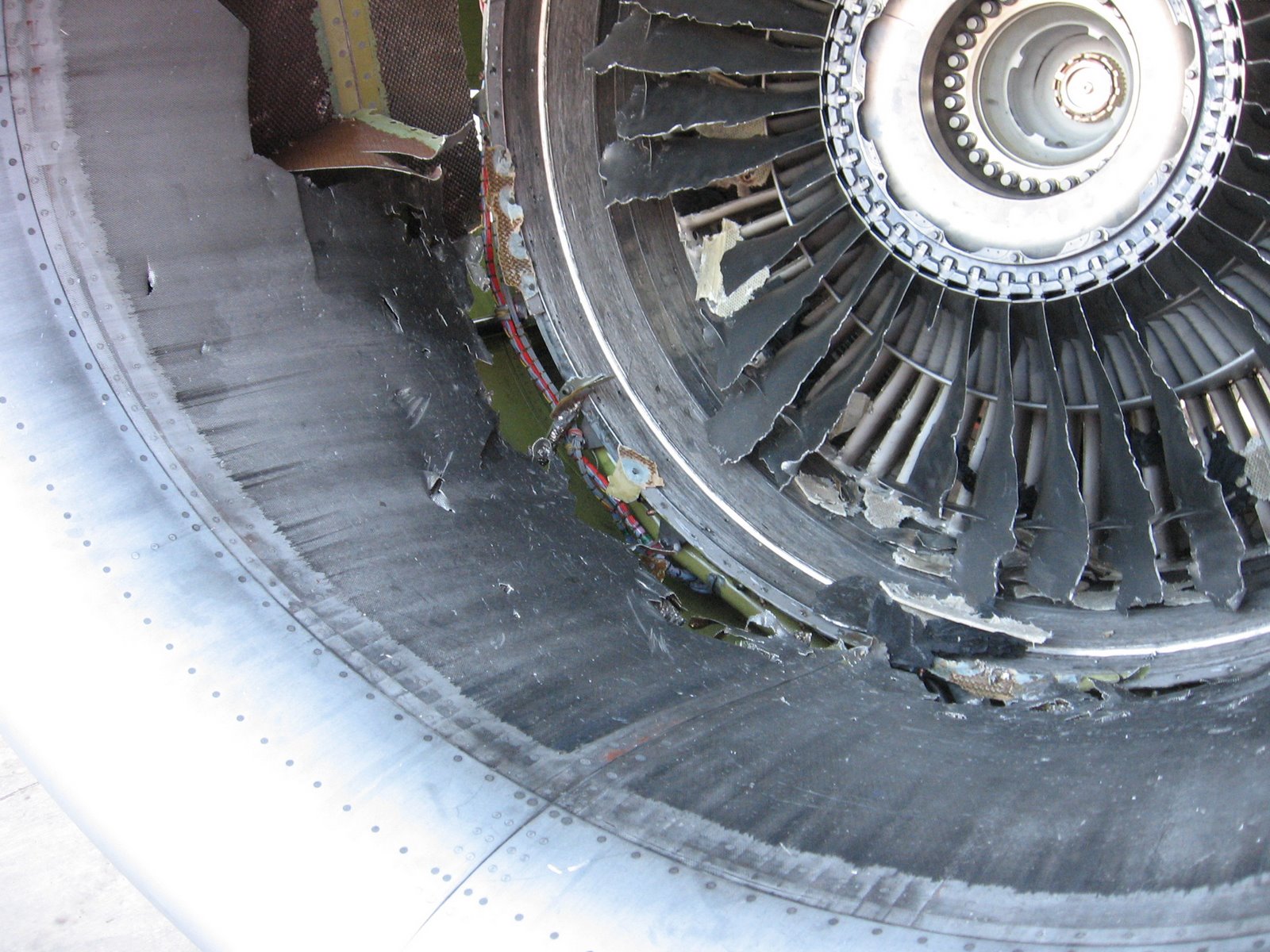Skip to comments.
Southwest flight makes emergency landing in Pensacola after mid-air engine failure
The Washington Times ^
| August 27, 2016
| Andrew Blake
Posted on 08/27/2016 2:37:42 PM PDT by jazusamo
click here to read article
Navigation: use the links below to view more comments.
first previous 1-20, 21-40, 41-60, 61-78 last
To: PAR35
I believe your third option is the correct answer. :)
61
posted on
08/27/2016 5:04:23 PM PDT
by
jazusamo
(Have YOU Donated to Free Republic? https://secure.freerepublic.com/donate/)
To: FreedomPoster
Looks like some damage to the wing root and the fuselage above it. The passengers were lucky.
62
posted on
08/27/2016 5:13:00 PM PDT
by
Moonman62
(Make America Great Again!)
To: aviator
“Oxygen masks were made available to passengers as the airline rapidly descended”
Sounds like a loss of pressure to me, but if they were drawing their air from that engine, it could be that there wasn’t a hull breach.
63
posted on
08/27/2016 5:32:09 PM PDT
by
PAR35
To: Kickass Conservative
Number two is the Emergency Only engine
64
posted on
08/27/2016 6:13:15 PM PDT
by
atc23
(The Confederacy was the single greatest conservative resistance to federal authority ever)
To: ProtectOurFreedom
So are you the only one offering information regarding the possible model of plane involved in this.
Jeeze- Reporting has taken such a turn for the worse. At one time the type of plane and model would have been in the headline.
So this is a Boeing?
65
posted on
08/27/2016 6:14:06 PM PDT
by
Revel
To: Mouton
Sully is such a false hero. He still had one good engine - no reason whatsoever to ditch in the river
66
posted on
08/27/2016 6:16:02 PM PDT
by
atc23
(The Confederacy was the single greatest conservative resistance to federal authority ever)
To: jazusamo
They have a good safety record. They just have more mishaps because they make a lot more flights than the others.
To: Moonman62
68
posted on
08/27/2016 6:28:55 PM PDT
by
FreedomPoster
(Islam delenda est)
To: atc23
"He still had one good engine - no reason whatsoever to ditch in the river" Source?
69
posted on
08/27/2016 6:34:02 PM PDT
by
Flag_This
(Liberals are locusts.)
To: Flag_This
http://www.wsj.com/articles/SB10001424052748703612804575222482042335978
Here is just one - the NTSB opted to NOT make the results public since the narrative was already cast. Nice book deal, Sully. LOL.
I know more than a few commercial pilots as well and they just snicker at the FALSE Sully hero story - such a joke
70
posted on
08/27/2016 6:45:33 PM PDT
by
atc23
(The Confederacy was the single greatest conservative resistance to federal authority ever)
To: atc23
"The results haven't changed the conclusions of National Transportation Safety Board investigators or outside aviation-safety experts, who unanimously agree that Mr. Sullenberger made the right call to put his crippled jet down in the river." Not impressed with the opinions of guys who were not at the controls when that accident happened. Everyone walked away from that landing.
71
posted on
08/27/2016 6:54:28 PM PDT
by
Flag_This
(Liberals are locusts.)
To: jazusamo
Yea, I made it OK, thanks.
To: Revel
Yep, Boeing. But it is an engine fault and the engines are made by the JV CFM. Their engines have an extremely high reliability rating. I won’t be surprised to learn this is a maintenance fault.
To: jazusamo

Check out the damaged engine photos with turbine and spinner shown in place, and compare to the above photo. The intake cowling/duct is shredded and torn away; but, the first by-pass turbine stage with center spinner is still nestled in place.
The welds of an upper and lower section of the cowling assembly project forward from both inboard/outboard positions of the center duct remnant. The engine likely ingested debris from the cowling; but, the blade ring is intact.
The ribbed bulkhead which the cowling attaches to is intact also. The turbine is inset back from this stiffening partition. Behind this partition begins the space filled with accessories, pumps, and so forth which surround the engine core.
For whatever reason whether material fatigue, impact with something, or explosion of the cowling itself--the intake portion of the engine and not the turbine itself appears to have disintegrated.
74
posted on
08/27/2016 8:50:23 PM PDT
by
Ozark Tom
(The binding rules only allow hints to be given freely in lieu of actual disclosures.)
To: 38special
That could be my favorite Twilight Zone.
75
posted on
08/27/2016 9:04:18 PM PDT
by
freefdny
To: ProtectOurFreedom
76
posted on
08/31/2016 5:00:06 PM PDT
by
BenLurkin
(The above is not a statement of fact. It is either satire or opinion. Or both.)
To: Ozark Tom
I do believe you are correct. The bypass fan (the front blades you see) and LP compressor disk didn't fail. The inlet cowling failed (I retract what I said earlier about compressor disk failure). Possibly compressor surge? Some parts left with a lot of velocity to strike the fuselage. There are other photos showing damage to the left rear horizontal stabilizer and left winglet, too.
There was a similar incident nine years ago. FAA: Southwest Engine Experienced Vibration. Passengers: The Engine Exploded!
More passenger info in a follow-up: Follow-up - Southwest Engine Failure
Here's the NTSB summary report of that incident in 2007:
NTSB Identification: ENG08IA002On November 17, 2007, a Southwest Airlines' Boeing 737-300, registration number N676SW, flight number 438, experienced a failure of the No. 2 engine, a CFM CFM56-3B1 while climbing through FL250 to FL330. The flight crew reported feeling severe vibration, pulled both throttles back to idle, declared an emergency, and started an air turn back to Love Field (DAL), Dallas, TX. While heading back to DAL, the pilot reported seeing the following cockpit warnings: a No. 2 constant speed drive (CSD) low oil pressure, No. 2 engine low oil pressure, No. 2 generator bus OFF, No. 2 pack trip OFF lights, and No. 2 engine vibration meter at 5 units. The pilot also reported that while heading back to DAL, the start lever on the No. 2 engine was CLOSED. An uneventful single engine landing was performed and no injuries were reported to any of the occupants. The incident flight was an IFR flight conducted under 14 CFR Part 121 from Dallas, Love Field, TX, to Little Rock (LIT), AR and was the third flight of the day for the aircraft. None of the 133 passengers and 5 on board were injured.
Examination of the airplane revealed impact marks along the fuselage from about 10 feet aft of the right-hand forward entry door to about 6 feet forward of the right-hand aft entry door and along almost the entire length of right wing leading edge. The right horizontal stabilizer also exhibited impact marks along almost the entire leading edge. None of airframe impact marks were punctures through the fuselage's pressure vessel.
Examination of the No. 2 engine revealed that all the fan blades exhibited heavy airfoil damage, all the fan blade roots remained installed in the disk, and several fan blades fractured near the platform. The forward and rear spinner cones were no longer attached to the fan disk and a large penetration hole was noted on the right-hand side of the fan cowl just forward of the engine fan case. No breaches of any of the engine cases or signs of fire damage were noted.
Metallurgical examination of the fracture surfaces of the fan blades and the fragments of the rear spinner aft flange at the Safety Board revealed no pre-existing fatigue type mechanism and all the fractures were consistent with overstress. Examination of all thirty-eight (38) fan blade spacers revealed no fretting marks on any of the front faces; however, four sequential spacers exhibited axial distortion of their lug in the forward direction. The engine manufacturer, CFM, concluded that a severe axial load rearward was applied to the spacers by the rear spinner cone prior to the spinner cone release and that the maximum force was localized where the distorted spacers were located.
Based on the lack of evidence for a pre-existing fatigue type fan blade or rear spinner fractures, and the physical evidence suggesting a possible single hard impact to the rear spinner as the initiating event causing the engine failure, possible external sources of foreign object ingestion were examined. A visual and fluorescent black light inspection was performed on all the fan blades, the fan inlet case, and the basic fan frame structure while the engine was still installed on the airplane, and the fan blades were again examined at the CFM Investigation Laboratory after they were removed from the fan disk. No bird remains or evidence of a bird ingestion event were found.
The Boeing 737 has had prior events where water leaking from the forward lavatory was suspected to have turned into ice during flight. This ice would depart from the airplane's forward service panel and be ingested into the No. 2 engine resulting in an in-flight shutdown of the No. 2 engine. Airworthiness Directives (AD) were issued to address the source of the leaks and to require periodic inspections to detect potential leaks. Review of Southwest Airlines' maintenance records for airplane N676SW revealed that the airplane had been modified and was inspected in accordance with the AD requirements. Examination of the maintenance write-ups prior to the No. 2 engine failure and after the airplane was returned to service showed no history or problems related to a leaky forward lavatory. Examination of the forward lavatory panel and the airplane skin in the vicinity of the forward lavatory panel revealed no signs of fluid streaks or leaks. Furthermore, the fan blades were subjected to an energy dispersive spectroscopy (EDS) analysis to document material transferred and deposited onto the fan blades. No unrecognizable material was found and all the material identified was consistent with material coming from either the inlet cowl or the spinner cone.
The characteristics of the damage in 2007 are very different from the current incident.

Speaking of FOD (foreign object debris), you don't want to get objects too close to the inlet with the engines running. They gulp a LOT of air...

To: ProtectOurFreedom
Speaking of FOD (foreign object debris), you don't want to get objects too close to the inlet with the engines running. They gulp a LOT of air... That's why Edna said.....

78
posted on
08/31/2016 6:37:37 PM PDT
by
dfwgator
Navigation: use the links below to view more comments.
first previous 1-20, 21-40, 41-60, 61-78 last
Disclaimer:
Opinions posted on Free Republic are those of the individual
posters and do not necessarily represent the opinion of Free Republic or its
management. All materials posted herein are protected by copyright law and the
exemption for fair use of copyrighted works.
FreeRepublic.com is powered by software copyright 2000-2008 John Robinson



